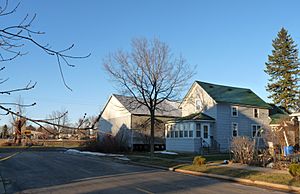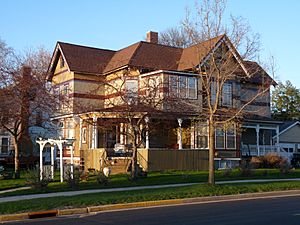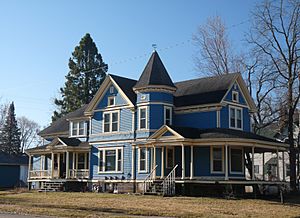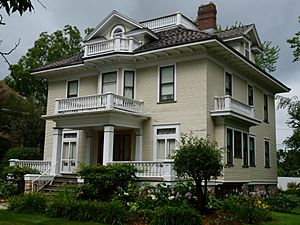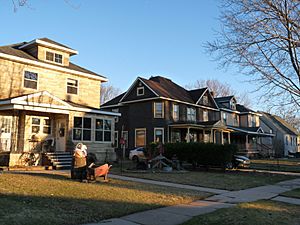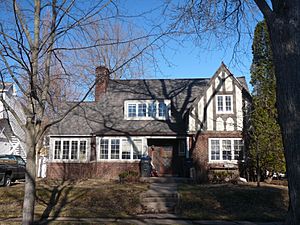Pleasant Hill Residential Historic District facts for kids
Quick facts for kids |
|
|
Pleasant Hill Residential Historic District
|
|
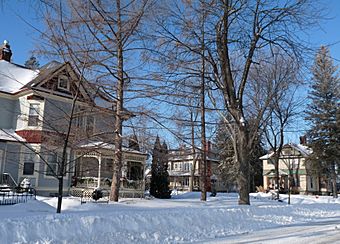
Winch house, Tiffault house, and Sexton house
|
|
| Location | Roughly bounded by E. First St., Ash Ave., E. Fourth St., and S. Cedar Ave., Marshfield, Wisconsin |
|---|---|
| Area | 24 acres (9.7 ha) |
| NRHP reference No. | 00000780 |
| Added to NRHP | July 5, 2000 |
The Pleasant Hill Residential Historic District is a special old neighborhood in Marshfield, Wisconsin. It's just a few blocks east of the city's downtown area. Most of the important buildings in this district were built between 1880 and 1949. You can find large, fancy homes built by business owners and professionals. There are also smaller, simpler homes built by workers. This area was added to the National Register of Historic Places in 2000. It's recognized for having many well-preserved historic buildings.
Contents
- How Marshfield Began
- Why "Pleasant Hill"?
- A Walk Through Time: Homes of Pleasant Hill
- The Oldest House: 107 S. Cherry
- The William Noll, Jr. House: Queen Anne Style
- The Eli Winch House: Classic Queen Anne
- The Frank Cady House: Queen Anne with Classical Touches
- The Wahle-Laird House: Georgian Revival Style
- The Peter and May Weber House: American Foursquare
- The I.P. Tiffault House: Eclectic Style
- The Dr. William Hipke House: Simpler Queen Anne
- The Schaefer House: Prairie Style
- The Bungalow at 309 E. 2nd Street
- The House at 204 S. Cherry: Colonial Revival
- The Wilson House: Tudor Revival Style
How Marshfield Began
Marshfield started in 1872. This was when the Wisconsin Central Railroad built its main track. This track was very close to where the Pleasant Hill neighborhood is now. Hotels and saloons opened first for the railroad workers and lumberjacks. Then, hardware stores and other shops followed.
Soon, factories like a sawmill and a furniture factory opened. Doctors and lawyers also started their practices. This small community grew very quickly. By 1885, about 2,090 people lived there. Imagine horses pulling noisy wagons. Lumberjacks walked along the unpaved Central Avenue. It could be muddy, dusty, or slushy depending on the weather.
Why "Pleasant Hill"?
The first big, fancy houses in Marshfield were built around 1880. These were for the leaders of the Upham Company. Their homes were west of Central Avenue, near their sawmill. This area is now called the Upham House Historic District.
Soon after, other business people and professionals began building large, stylish houses. They chose an area a few blocks east of Central Avenue. This place was probably already known as Pleasant Hill. It wasn't a very tall hill. But it was higher than Central Avenue. It must have felt much nicer than the dirt and noise of the main street.
A Walk Through Time: Homes of Pleasant Hill
The Pleasant Hill neighborhood does not have any Italianate-style buildings. Two houses of that style are in the older Upham House district. Those were built in 1880 and 1882. The oldest fancy house in Pleasant Hill was built after 1885. This was when Italianate homes were no longer as popular. House styles kept changing over the years. Here are some examples of houses in Pleasant Hill. They show different styles and are listed in the order they were built.
The Oldest House: 107 S. Cherry
The house at 107 S. Cherry Avenue is a simple two-story home. It has a front-gabled roof. Built in 1880 and added to in 1885, it is likely the oldest house still standing in the district. It was built very close to the railroad line. That line had only been laid eight years before.
The William Noll, Jr. House: Queen Anne Style
The William Noll, Jr. house is at 117 South Cherry. It is a large Queen Anne-style house. It was built in 1891. This home has two and a half stories. It features a mix of hip and gable roofs. You can see an eyebrow window, bay windows, and a porch that wraps around the house. The upper stories have decorative fish scale shingles. William Jr. was the son of William Noll Sr., who started Noll Hardware. William Jr. worked in the family store on Central Avenue.
The Eli Winch House: Classic Queen Anne
The Eli Winch house is at 201 S. Vine Ave. (It's on the left in the top photo). This is a classic Queen Anne style house. Hans Billie, a well-known builder in Marshfield, built it in 1897. Queen Anne homes are known for their uneven shapes and complex roofs. This house also has bay windows and a wraparound porch. It uses different textures and colors, like clapboard and shingles. Eli Winch owned the Marshfield Stave Factory. He was also a state legislator.
The Frank Cady House: Queen Anne with Classical Touches
The Frank Cady house is at 400 E. 3rd Street. This is another Queen Anne house. It has many features like the Winch house. It also has a corner tower and a wraparound porch. These are common Queen Anne details. However, this house also has round columns and gables with triangular tops. These elements show a move towards the Classical Revival style. Lawyer Frank Cady had this house built in 1898.
The Wahle-Laird House: Georgian Revival Style
The Wahle-Laird House is at 208 S. Cherry Avenue. It's a beautiful Georgian Revival house. Dr. Henry Wahle built it in 1904. In 1923, W.D. Connor bought it. He was a lumber businessman and a well-known progressive Republican. He lived across the street. He bought the house for his daughter, Helen Connor Laird, and her husband, Rev. Melvin Laird. Their son, Melvin Laird, grew up in this house. He later became a U.S. congressman and U.S. Secretary of Defense.
The Peter and May Weber House: American Foursquare
The house at 305 S. Cedar Ave. is an American Foursquare-style home. It was built in 1905. This style usually has a simple, square shape with a hipped roof. The front porch was originally open. The house was covered in clapboard siding. Peter and May Weber had this house built.
The I.P. Tiffault House: Eclectic Style
The I.P. Tiffault house is at 206 S. Vine (in the center of the top photo). It's a two-and-a-half-story house built in 1908. It has an eclectic style, meaning it mixes different looks. Its general square shape could be American Foursquare. But its balanced design and small triangular shapes in the gables suggest Classical Revival style. The horizontal lines and long, narrow windows also hint at Prairie School design. Isadoris Tiffault came from New York in 1887. He ran a store with P.J. Kraus. Later, he co-owned the Tiffault and Kamps Department Store.
The Dr. William Hipke House: Simpler Queen Anne
The Dr. William Hipke house is at 212 S. Vine Avenue. It's a late Queen Anne house built around 1911. By this time, people realized how much work it was to paint large Queen Anne homes. Their complex roofs could also leak. So, designs started to become simpler. Other than one bay window, this house has a simple rectangular shape and a gable roof. It still has the uneven wraparound porch and shingles in the gable end, typical of Queen Anne. But the round columns and roofline details come from the Classical Revival style, which was becoming popular. Dr. Hipke was one of the five people who started the Marshfield Clinic.
The Schaefer House: Prairie Style
The Schaefer house at 312 E. 3rd Street is a two-story brick Prairie style house. Earl F. Miller from Manitowoc designed it. It was built in 1912. This style is known for its low-pitched hip roof and wide, overhanging eaves. It also features long, narrow windows and a focus on horizontal lines. This house has a covered driveway called a porte-cochère on the side. P.J. Schaefer was a cheese seller and a vice president of the First National Bank. Around 1932, he sold the house to Dr. McGinn. Prairie style was an attempt to create a new American architectural style. It was not based on European designs like Italianate and Queen Anne.
The Bungalow at 309 E. 2nd Street
The house at 309 E. 2nd Street is a great example of a bungalow. It has one and a half stories. The roof ridge runs parallel to the street. It features a shed-roofed dormer, banded windows, and multiple small panes in the upper parts of the windows. Like Prairie style, bungalows were seen as modern at the time. They were not based on European styles. They were convenient and practical for middle-class families.
The House at 204 S. Cherry: Colonial Revival
The house at 204 S. Cherry Avenue is a good example of the Colonial Revival style. Key features include a hip roof and a front door in the center. The door has narrow windows on the sides and a fan-shaped window above. The windows are placed evenly, and the porch is supported by columns. This house was built in 1926.
The Wilson House: Tudor Revival Style
The house at 210 South Vine is in the Tudor Revival style. This style is known for its steep rooflines and decorative half-timbering. It also often has a large chimney. This house was built in 1926 for a Mr. and Mrs. Wilson. Mr. Wilson was a retired Presbyterian minister from Wausau.
This Tudor Revival house is the only one of its kind in the district. By the time this style became popular, Pleasant Hill was mostly full. The house at 210 S. Vine might have replaced an older home. Or, it could have been built on a large lot that was divided into smaller pieces. For the same reason, newer styles like ranch homes are not found in this district. Many ranch homes are found on Marshfield's west side, beyond Oak Avenue. That area was developed later.


